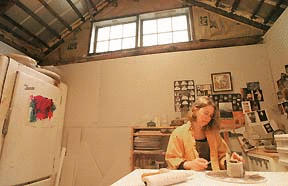If buildings burst out in scales, they might resemble Gail Hustedde’s ceramics.
Hustedde combines architecture and patterns in nature to make the clay works she shows at Bainbridge Arts and Crafts through March.
“I used to make big garden pots,” Hustedde said. “But the new work is much more interesting and I’m really enjoying the intimacy of the smaller scale of these works.”
Some of the pieces – candle holders, for example, or cups – are explicitly functional, but her work also includes enigmatic architectural pieces.
Small containers with gabled roofs, they resemble alabaster containers found in Tut’s tomb.
Hustedde, who teaches pottery classes at Olympia Pottery and Art, Clackamas Community College and the Bainbridge Park District, says her work draws on several artistic traditions.
“I am looking at sculpture history,” Hustedde admits. “Another influence is Chinese bronze.”
After obtaining her masters degree in ceramics at the University of Idaho at Moscow in 1981, Hustedde took extended classes and workshops at the famed Archie Bray Foundation in Helena, Montana and the equally renowned New York College of Ceramics at Alfred, New York.
Hustedde uses porcelainous stoneware to build her ceramics, rolling flat pieces of clay that she then textures with scales, scallops and plant leaves. Next, she “cuts out” clay shapes, using a paper template as a guide. With different flat pieces to choose from, she begins to construct the three-dimensional shapes.
The process gives Hustedde the same sort of flexibility in three dimensions that collage might offer a painter.
The forms get two layers of high-fire glaze – the first collects in the recessed areas of the surface to highlight the texture, and then the whole piece is dipped.
The result is a milky white glaze over subtle green highlights.
A few pieces in the show are “soda fire,” a firing process in which sodium bicarbonate is introduced into the kiln chamber as the glazes are starting to melt. Potters call the resulting pebbly surface “orange peel.”
The geometric forms in Hustedde’s work create a grid that contrasts with the organic surface textures.
Like a skeleton, the grid forms the visual substructure on which the rest of the piece is “hung.”
Hustedde’s skill keeps the regularity of the grid – an organizing principle artist often employ – from being monotonous.
“My forms are getting more geometric,” Hustedde said. “I guess I am beginning to embrace my German-Scandinavian heritage in my art.”
* * * * *
BAC features ceramic works by Gail Hustedde through March. Hustedde shares the gallery with pastel artist Scott Allen. Call 842-3132 for more information.



